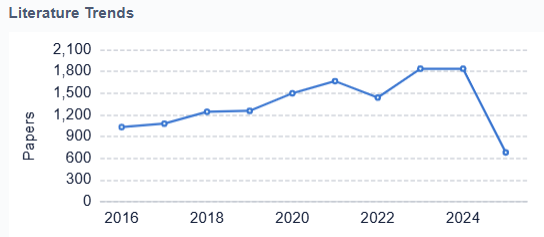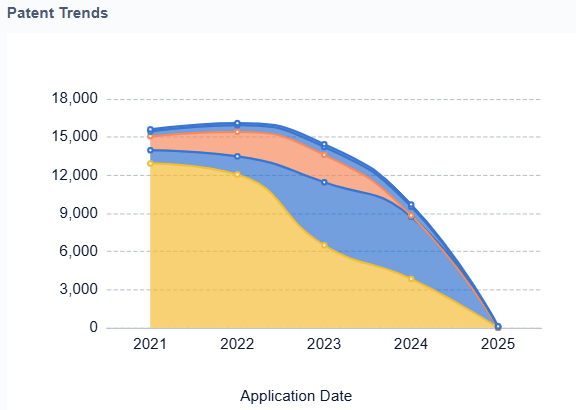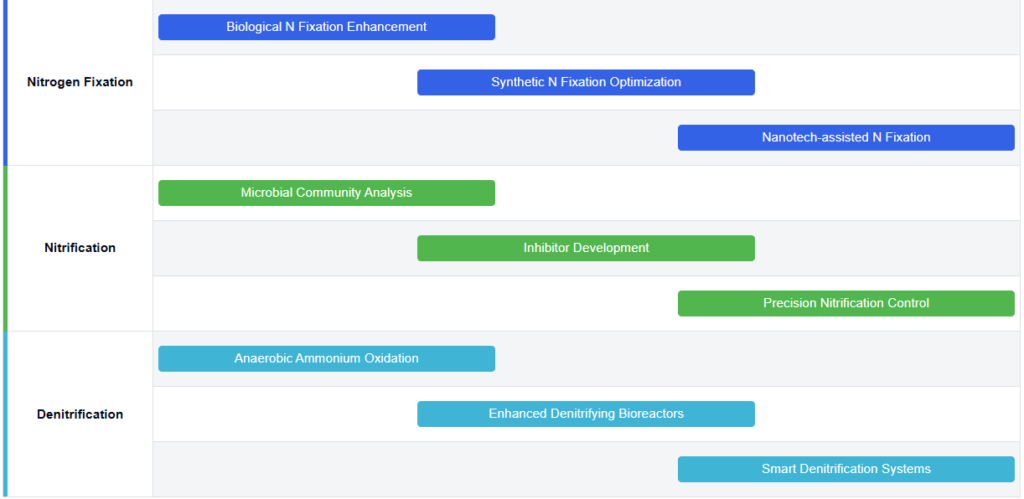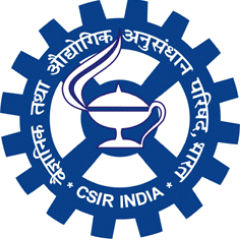
Nitrogen Cycle Overview and Research Objectives
The nitrogen cycle is a fundamental biogeochemical process that plays a crucial role in sustaining life on Earth. It involves the transformation and movement of nitrogen through various forms in the atmosphere, terrestrial ecosystems, and aquatic environments. This complex cycle has been the subject of extensive research due to its significant impact on global ecosystems, agricultural productivity, and environmental health. The study of the nitrogen cycle encompasses a wide range of disciplines, including microbiology, soil science, atmospheric chemistry, and ecology.
Trying to connect the dots between electrochemical principles and biogeochemical cycles like the nitrogen cycle? Eureka Technical Q&A links you with experts in chemistry and environmental science who can break down how redox reactions, microbial processes, and galvanic principles intersect—helping you grasp complex systems with clarity and confidence.
Over the past century, human activities have dramatically altered the natural nitrogen cycle, leading to both benefits and challenges. The development of the Haber-Bosch process for industrial nitrogen fixation has revolutionized agriculture, enabling increased food production to support a growing global population. However, this anthropogenic intervention has also resulted in unintended consequences, such as eutrophication of water bodies, soil acidification, and increased greenhouse gas emissions.

The primary objective of current research on the nitrogen cycle is to gain a comprehensive understanding of its processes, drivers, and impacts in the context of global environmental change. This includes investigating the microbial communities responsible for key nitrogen transformations, quantifying nitrogen fluxes across different ecosystems, and developing innovative strategies for sustainable nitrogen management in agriculture and industry.
Recent technological advancements have enabled researchers to explore the nitrogen cycle at unprecedented scales and resolutions. High-throughput sequencing techniques have revealed the diversity and functional capabilities of nitrogen-cycling microorganisms, while stable isotope approaches have provided insights into nitrogen transformation rates and pathways. Remote sensing and modeling tools are increasingly being used to assess nitrogen dynamics at regional and global scales.
Looking ahead, future research directions in the nitrogen cycle field are likely to focus on several key areas. These include elucidating the impacts of climate change on nitrogen cycling processes, developing novel biological nitrogen fixation technologies, optimizing nitrogen use efficiency in agriculture, and exploring the potential of circular economy approaches to nitrogen management. Additionally, there is growing interest in understanding the interactions between the nitrogen cycle and other biogeochemical cycles, such as carbon and phosphorus, to address complex environmental challenges.

As we continue to unravel the intricacies of the nitrogen cycle, the ultimate goal is to develop sustainable strategies for managing nitrogen in a way that balances human needs with environmental protection. This requires a multidisciplinary approach, combining cutting-edge scientific research with policy innovations and stakeholder engagement to ensure the long-term health of our planet’s ecosystems.
Environmental Impact and Agricultural Demand
The nitrogen cycle plays a crucial role in both environmental sustainability and agricultural productivity. As global population continues to grow, the demand for food production has intensified, leading to increased use of nitrogen-based fertilizers. This has resulted in significant environmental impacts, including water pollution, soil degradation, and greenhouse gas emissions. Nitrate runoff from agricultural lands contributes to eutrophication in water bodies, causing algal blooms and oxygen depletion. Additionally, the production and use of synthetic nitrogen fertilizers contribute to greenhouse gas emissions, particularly nitrous oxide, which has a global warming potential 298 times that of carbon dioxide.
The agricultural sector faces the challenge of meeting rising food demand while minimizing environmental impacts. Nitrogen use efficiency in agriculture remains low, with only 30-50% of applied nitrogen being utilized by crops. This inefficiency not only represents economic losses for farmers but also exacerbates environmental issues. There is a growing recognition of the need for sustainable nitrogen management practices that can balance agricultural productivity with environmental protection.
Innovations in precision agriculture and smart farming technologies offer promising solutions for optimizing nitrogen use. These include sensor-based fertilizer application systems, drone-based crop monitoring, and data-driven decision support tools. Such technologies enable farmers to apply nitrogen more precisely, matching crop needs and reducing excess application. Additionally, the development of enhanced efficiency fertilizers, such as controlled-release formulations and nitrification inhibitors, shows potential for improving nitrogen use efficiency and reducing environmental losses.
The demand for organic and sustainable farming practices is also driving innovation in biological nitrogen fixation and the use of leguminous cover crops. These approaches harness natural processes to supply nitrogen to crops, reducing reliance on synthetic fertilizers. Furthermore, there is increasing interest in circular economy approaches, such as recovering and recycling nitrogen from waste streams, including animal manure and food waste.
As awareness of the environmental impacts of nitrogen use grows, regulatory frameworks are evolving to address these challenges. Many regions are implementing stricter regulations on nitrogen application rates and timing, as well as mandating best management practices. This regulatory landscape is likely to shape future agricultural practices and drive further innovation in nitrogen management technologies.
Looking ahead, the integration of artificial intelligence and machine learning in agriculture holds promise for further optimizing nitrogen use. These technologies could enable more accurate prediction of crop nitrogen requirements based on real-time environmental data and crop growth models. Additionally, ongoing research into crop genetics aims to develop varieties with improved nitrogen use efficiency, potentially reducing the overall nitrogen input required for optimal yields.
Current Challenges in Nitrogen Cycle Management
The management of the nitrogen cycle presents several significant challenges in today’s world. One of the primary issues is the excessive use of nitrogen-based fertilizers in agriculture, leading to nutrient runoff and pollution of water bodies. This overuse not only contributes to eutrophication in aquatic ecosystems but also results in the formation of harmful algal blooms and dead zones in coastal areas. Additionally, the volatilization of ammonia from fertilizers and animal waste contributes to air pollution and acid rain, further exacerbating environmental concerns.
Another major challenge is the inefficient use of nitrogen in agricultural systems. Despite the application of large quantities of nitrogen fertilizers, crops often absorb only a fraction of the applied nitrogen, leading to substantial waste and environmental impact. This inefficiency is compounded by soil degradation and the loss of organic matter, which reduces the soil’s natural ability to retain and cycle nutrients.

The increasing demand for food production to feed a growing global population puts additional pressure on nitrogen management. As agricultural intensification continues, there is a need to balance increased productivity with sustainable nitrogen use. This balance is particularly challenging in developing countries, where access to advanced technologies and management practices may be limited.
Climate change further complicates nitrogen cycle management. Altered precipitation patterns and temperature regimes affect soil microbial activity, potentially disrupting natural nitrogen cycling processes. Moreover, the increased frequency of extreme weather events can lead to greater nitrogen losses through leaching and erosion.
The complex interplay between the nitrogen cycle and other biogeochemical cycles, such as the carbon cycle, presents additional challenges. For instance, efforts to increase soil carbon sequestration may inadvertently affect nitrogen dynamics, requiring a holistic approach to ecosystem management.

In urban and industrial settings, the management of nitrogen in wastewater and atmospheric emissions remains a significant challenge. Improving wastewater treatment technologies and reducing nitrogen oxide emissions from combustion processes are ongoing areas of focus.
Lastly, the global nature of the nitrogen cycle necessitates international cooperation and policy coordination. Differences in regulatory frameworks, economic priorities, and technological capabilities across countries make it difficult to implement consistent and effective nitrogen management strategies on a global scale. Addressing these challenges requires a multifaceted approach, combining technological innovations, policy interventions, and improved management practices to optimize nitrogen use efficiency while minimizing environmental impacts.
Historical Milestones in Nitrogen Cycle Research


Key Stakeholders in Nitrogen Cycle Research
The nitrogen cycle research field is in a mature stage, with ongoing innovations and global interest. The market size for related technologies and applications is substantial, driven by agricultural, environmental, and industrial needs. Technologically, the field is well-established but continues to evolve. Companies like Air Products & Chemicals, Inc. and Crop Intellect Ltd. are developing advanced solutions for nitrogen management. Academic institutions such as Tsinghua University and the University of Southern California are contributing to fundamental research. Environmental concerns and sustainability goals are pushing for more efficient nitrogen utilization, with organizations like AgResearch Ltd. and the Korea Research Institute of Chemical Technology focusing on eco-friendly approaches. The competitive landscape is diverse, involving both established players and innovative startups, indicating a dynamic and evolving sector.
 Tsinghua University
Tsinghua University
Technical Solution
Tsinghua University has made significant contributions to understanding and improving the nitrogen cycle. Their research includes developing advanced wastewater treatment technologies for nitrogen removal, such as the anammox process, which utilizes anaerobic ammonium-oxidizing bacteria to convert ammonium and nitrite directly to nitrogen gas. They have also worked on improving nitrogen recovery from waste streams, developing novel adsorbents and membrane technologies for selective nitrogen capture. Furthermore, Tsinghua researchers are exploring the use of artificial intelligence and machine learning to optimize nitrogen management in agricultural systems.
Strengths: Strong interdisciplinary approach, cutting-edge research in wastewater treatment and nitrogen recovery, integration of AI in nitrogen management.
Weaknesses: Some technologies may be complex to implement in less developed regions, potential high initial investment costs.
 Council of Scientific & Industrial Research
Council of Scientific & Industrial Research
Technical Solution
CSIR has developed innovative approaches to enhance nitrogen use efficiency in agriculture. Their research focuses on developing slow-release nitrogen fertilizers using nanotechnology, which can reduce nitrogen losses through leaching and volatilization. They have also explored the use of nitrification inhibitors to slow down the conversion of ammonium to nitrate, thereby reducing nitrate leaching. Additionally, CSIR is working on developing nitrogen-fixing microbial consortia that can enhance biological nitrogen fixation in non-leguminous crops.
Strengths: Comprehensive research approach, focus on sustainable agriculture, expertise in nanotechnology and microbiology.
Weaknesses: Potential high costs of implementation, need for extensive field trials before widespread adoption.
 Crop Intellect Ltd.
Crop Intellect Ltd.
Technical Solution
Crop Intellect has developed a range of innovative products and technologies to optimize nitrogen use in agriculture. Their flagship product, N-Fix, is a seed treatment that enables non-legume crops to fix atmospheric nitrogen, potentially reducing the need for synthetic nitrogen fertilizers. They have also developed smart fertilizer formulations that release nitrogen in response to plant demand and environmental conditions. Additionally, Crop Intellect is working on AI-powered decision support tools that help farmers optimize nitrogen application timing and rates based on real-time crop and soil data.
Strengths: Innovative approach to biological nitrogen fixation, integration of smart technologies in fertilizer management, focus on practical solutions for farmers.
Weaknesses: Limited track record compared to larger research institutions, potential regulatory hurdles for novel biological products.
AgResearch Ltd.
Technical Solution
AgResearch has developed innovative solutions to mitigate nitrogen losses in agricultural systems. Their research includes the development of novel plant varieties with improved nitrogen use efficiency, such as grasses with deeper root systems that can capture more soil nitrogen. They have also worked on precision agriculture techniques, using remote sensing and GIS technologies to optimize nitrogen application rates based on spatial variability in soil and crop conditions. Additionally, AgResearch has conducted extensive research on the use of nitrification inhibitors and biochar to reduce nitrogen leaching and improve soil health.
Strengths: Strong focus on practical, farm-level solutions, extensive field testing capabilities, expertise in plant breeding and soil science.
Weaknesses: Some solutions may be specific to New Zealand’s agricultural systems and may require adaptation for other regions.
 Monash University
Monash University
Technical Solution
Monash University has conducted extensive research on various aspects of the nitrogen cycle. Their work includes studying the microbial processes involved in nitrogen transformations in soil and water, developing novel sensors for real-time monitoring of nitrogen compounds in the environment, and exploring the impacts of climate change on nitrogen cycling. Monash researchers have also made significant contributions to understanding the role of nitrogen in marine ecosystems, including the impacts of nitrogen pollution on coral reefs. Additionally, they are working on developing sustainable nitrogen management strategies for urban environments, including green infrastructure solutions for nitrogen removal from stormwater.
Strengths: Comprehensive research covering terrestrial, aquatic, and urban nitrogen cycling, strong focus on environmental impacts and sustainability, expertise in sensor technology.
Weaknesses: Some research areas may be more theoretical and require further development for practical applications.
Existing Nitrogen Management Strategies
Nitrification process in the nitrogen cycle
Nitrification is a key process in the nitrogen cycle where ammonia is oxidized to nitrite and then to nitrate by nitrifying bacteria. This process is crucial in wastewater treatment, agriculture, and natural ecosystems. It involves two steps: ammonia oxidation to nitrite by ammonia-oxidizing bacteria, followed by nitrite oxidation to nitrate by nitrite-oxidizing bacteria.
- Biological nitrification process
The biological nitrification process involves the oxidation of ammonia to nitrite and then to nitrate by specific bacteria. This two-step process is crucial in the nitrogen cycle, converting ammonia into forms that can be utilized by plants. The process is influenced by factors such as temperature, pH, and oxygen availability. - Wastewater treatment using nitrification
Nitrification plays a vital role in wastewater treatment systems. It helps remove nitrogen compounds from wastewater, reducing the potential for eutrophication in receiving water bodies. Various technologies and methods are employed to optimize the nitrification process in treatment plants, including the use of specialized reactors and biofilm systems. - Soil nitrification and agricultural applications
Nitrification in soil is essential for plant nutrition and agricultural productivity. It converts ammonium from fertilizers or organic matter decomposition into nitrate, which is readily absorbed by plants. Understanding and managing soil nitrification is crucial for optimizing fertilizer use efficiency and minimizing environmental impacts in agriculture. - Inhibition and control of nitrification
In certain scenarios, controlling or inhibiting nitrification is desirable. This includes situations where nitrate leaching needs to be reduced or when slow-release nitrogen fertilizers are used. Various chemical and biological inhibitors can be employed to regulate the nitrification process, allowing for better management of nitrogen in different environmental and agricultural contexts.
Denitrification in nitrogen cycling
Denitrification is an anaerobic process where nitrate is reduced to nitrogen gas, completing the nitrogen cycle. This process is important in wastewater treatment, soil management, and marine ecosystems. It involves several steps, including the reduction of nitrate to nitrite, nitric oxide, nitrous oxide, and finally to dinitrogen gas, carried out by denitrifying bacteria.Expand
Nitrogen fixation techniques
Nitrogen fixation is the process of converting atmospheric nitrogen into biologically available forms. This can occur naturally through lightning or biological nitrogen fixation by certain microorganisms, or artificially through industrial processes. Techniques for enhancing nitrogen fixation are crucial for agriculture and ecosystem management.Expand
Ammonification in the nitrogen cycle
Ammonification is the process of converting organic nitrogen compounds into ammonia. This process is carried out by decomposer organisms in soil and aquatic environments. It is a crucial step in the nitrogen cycle, releasing nitrogen from organic matter and making it available for other processes like nitrification.Expand
Nitrogen cycle management in ecosystems
Managing the nitrogen cycle in various ecosystems involves techniques to optimize nitrogen use efficiency, reduce nitrogen losses, and mitigate environmental impacts. This includes strategies for agricultural systems, wastewater treatment, and natural ecosystem conservation. Proper management is crucial for sustainable food production and environmental protection.
Breakthrough Technologies in Nitrogen Fixation




Future Directions in Nitrogen Cycle Optimization
Enhanced Biological Nitrogen Fixation
Enhanced Biological Nitrogen Fixation (EBNF) offers a cutting-edge solution to reduce the agricultural sector’s dependence on synthetic nitrogen fertilizers. This approach focuses on improving the natural process of converting atmospheric nitrogen into plant-available forms by enhancing the efficiency of nitrogen-fixing bacteria. Through genetic engineering and microbial management, EBNF aims to boost crop yields while promoting sustainability.
1. Genetic Enhancement of Nitrogen-Fixing Bacteria
Researchers are working to improve nitrogen fixation in key bacteria like Rhizobium and Bradyrhizobium. They modify and amplify genes responsible for producing nitrogenase enzymes—crucial components in the nitrogen fixation process. These enhanced microbes can convert nitrogen more efficiently, increasing their impact on plant growth.
2. Strengthening Plant-Microbe Symbiosis
EBNF also targets the interaction between plants and nitrogen-fixing bacteria. Scientists are improving plant signaling pathways to better attract beneficial microbes. This leads to stronger root colonization and more efficient nodule formation, which supports better nitrogen absorption by plants.
3. Expanding the Host Range to Non-Legumes
One of the most transformative aspects of EBNF is the effort to extend nitrogen-fixing capabilities to non-leguminous crops like wheat, rice, and corn. By enabling these staple crops to form symbioses with nitrogen-fixing bacteria, researchers hope to significantly reduce fertilizer use in global agriculture.
4. Optimizing Microbial Communities in Soil
To maximize EBNF benefits, scientists are studying the entire soil microbiome. They aim to create environments that favor nitrogen-fixing organisms, promoting overall soil health and boosting nitrogen availability for plants.
5. Developing Effective Bioinoculants
Advanced bioinoculants are being developed to ensure the survival and performance of beneficial microbes in diverse field conditions. These formulations are applied to seeds or soil and are tailored to specific crops and soil types for maximum effectiveness.
Implementation Strategies for EBNF
To make EBNF a practical solution, experts recommend several key steps:
- Conduct large-scale field trials to test enhanced microbes under varied environmental conditions.
- Create crop-specific inoculant products suited to different soils and climates.
- Launch farmer education programs to promote proper use of bioinoculants and sustainable farming techniques.
- Integrate EBNF with precision agriculture tools to ensure targeted, data-driven application.
Potential Impact of EBNF
Widespread adoption of EBNF could significantly reduce synthetic fertilizer use, which is energy-intensive and often harmful to ecosystems when overapplied. By enhancing natural nitrogen cycles, EBNF supports environmentally friendly farming and aligns with global sustainability goals. It also opens new pathways to improve food security and lower agricultural emissions.
Strengths of EBNF
- Reduces dependence on synthetic fertilizers and lowers production costs.
- Improves soil health by enriching microbial diversity.
- Applies to a broad range of crops, including non-legumes.
- Aligns with sustainable and regenerative agriculture practices.
Challenges and Limitations
- Complex plant-microbe interactions can lead to inconsistent results across regions.
- Genetically modified organisms face strict regulatory scrutiny.
- Adoption may require new farming techniques and farmer education.
- Soil types and climate variability may impact overall effectiveness.
Policy Framework for Nitrogen Use Regulation
Regulating nitrogen use is essential for reducing environmental harm and supporting sustainable agriculture. Governments around the world have developed diverse policy frameworks to manage nitrogen pollution and promote efficient nitrogen use. These policies typically address three major areas: agricultural practices, industrial emissions, and wastewater management.
Agricultural Nitrogen Use
In agriculture, overuse of nitrogen fertilizers often leads to runoff and water pollution. To prevent this, many countries have introduced strict fertilizer application guidelines. For example, the European Union’s Nitrates Directive sets limits on nitrogen use and requires member states to create action plans for reducing nitrate pollution. In the United States, policies like the National Strategy to Promote the Health of Honey Bees and Other Pollinators aim to reduce the environmental impact of fertilizers and pesticides.
Industrial Nitrogen Emissions
Industry also contributes to nitrogen pollution, mainly through the release of nitrogen oxides (NOx). Governments regulate NOx through air quality laws and emissions standards. The U.S. Clean Air Act requires power plants, factories, and vehicles to use the best available technologies to reduce NOx emissions. Some regions have implemented cap-and-trade systems to create economic incentives for lowering emissions, allowing companies to trade emission allowances.
Wastewater Treatment Standards
Wastewater treatment plays a major role in managing nitrogen discharge into rivers and lakes. Many countries have set effluent limits for nitrogen in treated water. For instance, the EU’s Urban Waste Water Treatment Directive outlines nitrogen removal requirements for treatment plants serving large populations. These standards aim to protect water quality and reduce the risk of eutrophication.
International Agreements
Global and regional agreements also shape nitrogen policy. The United Nations Convention on Long-range Transboundary Air Pollution (CLRTAP) addresses nitrogen emissions that cross national borders. Region-specific efforts like the Baltic Sea Action Plan focus on reducing nitrogen loads in sensitive ecosystems, using collaborative strategies among neighboring countries.
Evolving Regulatory Approaches
As science improves our understanding of the nitrogen cycle, policies are evolving. Future frameworks will likely take a more integrated approach, addressing nitrogen use across sectors rather than in isolation. Governments may begin developing nitrogen budgets at national or regional levels to monitor and manage nitrogen flows more effectively.
Additionally, regulators are exploring flexible mechanisms that adapt to local environmental conditions and socioeconomic factors. These new strategies aim to balance agricultural productivity with ecosystem protection, paving the way for smarter and more sustainable nitrogen management.
Ecological Implications of Nitrogen Cycle Disruption
Disrupting the nitrogen cycle causes widespread ecological damage across land, water, and air systems. Human activities, especially agriculture and industry, continue to alter nitrogen flows, leading to serious environmental consequences.
Aquatic Impacts: Eutrophication and Dead Zones
One of the most visible effects occurs in aquatic ecosystems. When excess nitrogen enters lakes, rivers, and coastal waters, it fuels rapid algal growth. These algal blooms block sunlight and deplete oxygen, creating dead zones where few organisms can survive. As a result, water quality declines, biodiversity suffers, and food chains break down.
Terrestrial Impacts: Soil Degradation and Plant Stress
On land, nitrogen disruption alters soil chemistry. High nitrogen levels lead to soil acidification, which affects nutrient availability and harms plant roots. Certain species thrive in high-nitrogen soils, while others decline, causing shifts in plant communities and potential biodiversity loss. Additionally, excess nitrogen makes some plants more vulnerable to pests and diseases, further weakening ecosystem balance.
Atmospheric Impacts: Air Pollution and Climate Change
The nitrogen cycle also affects the atmosphere. Emissions of nitrogen oxides (NOx) and ammonia (NH₃) from vehicles and fertilizers contribute to air pollution. These gases form particulate matter and ground-level ozone, which harm human health and damage vegetation. Moreover, nitrogen cycle disruption increases nitrous oxide (N₂O) emissions—a powerful greenhouse gas that accelerates climate change and feeds back into ecosystem disruption.
Impacts on Wildlife and Ecosystem Services
Wildlife also faces serious risks. Changes in plant life and water quality reduce suitable habitats for many species. These shifts can cause population declines or force animals to migrate. Such changes threaten ecosystem services like pollination, pest control, and nutrient cycling, which are essential for both ecosystems and human well-being.
Addressing the Challenge: Sustainable Nitrogen Management
As global populations grow and agriculture expands, managing nitrogen becomes more urgent. Solutions like precision agriculture and nitrogen-efficient crop varieties offer hope. These technologies reduce fertilizer use while maintaining yields. However, lasting progress requires comprehensive strategies that address both direct and diffuse sources of nitrogen pollution. Policies must consider the full nitrogen cycle and its complex links across ecosystems.
To get detailed scientific explanations of , try Patsnap Eureka.


